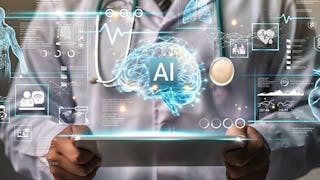医疗保健行业的未来正取决于我们将机器学习和人工智能整合到组织中的能力。但是,仅仅认识到人工智能的机遇是不够的;作为医疗保健行业的领导者,我们必须首先确定这些应用的最佳用途,确保我们将投资重点放在解决影响底线的问题上。


了解顶级公司的员工如何掌握热门技能

积累特定领域的专业知识
- 向行业专家学习新概念
- 获得对主题或工具的基础理解
- 通过实践项目培养工作相关技能
- 获得可共享的职业证书

该课程共有4个模块
技术的日新月异影响着现代社会的方方面面,医疗保健行业也不例外。无论您目前是在该行业工作,还是希望进入新的岗位,或者只是对医疗保健行业如何使用技术感兴趣,驾驭这些变化都至关重要。毫无疑问,在过去几年中,你听到 "机器学习 "和 "人工智能 "这些术语的频率越来越高,但这对你或整个医疗保健行业意味着什么呢?跟上不断变化的趋势,研究决策支持的潜在用途,找出一些可以解决的痛点,是我们将在本模块中讨论的一些主题。
涵盖的内容
15个视频4篇阅读材料6个作业2个讨论话题
让我们来了解一下如何预测健康结果和成本。如果我们能在您的机构中使用机器学习来降低机构和接受护理的会员的护理成本,会怎样?您是否考虑过需要收集哪些数据?您可能需要如何丰富这些数据,以便更深入地了解是什么在驱动这些结果和成本?或者您可以利用哪种机器学习算法来最有效地定位可能高成本的患者?我们不仅要探讨预测背后的技术,还要研究医疗行业内的业务和数据关系,这些关系最终会影响您提供有效解决方案的能力。
涵盖的内容
9个视频2篇阅读材料5个作业1次同伴评审1个讨论话题
既然我们已经讨论了各种类型的预测模型,那么让我们来看看哪些模型适合我们试图解决的业务案例,以及如何评估它们的性能。例如,在预测个人健康与群体健康时,使用相同的性能指标是否合适?在本模块中,我们将讨论如何在预测分析和机器学习的基础上分层使用适当的决策支持方法,从而为显著提高整体推广和生产效率以及降低成本奠定基础。最后,我们将讨论将决策支持融入现有业务工作流程和技术基础设施生态系统的关键。
涵盖的内容
9个视频1篇阅读材料6个作业1个讨论话题
既然我们已经知道决策支持和预测建模的重要性,那么我们就要更进一步。我们不仅需要预测,更重要的是,我们需要开出处方。仅仅实施警报和提醒是不够的,我们需要为医疗保健专业人员提供指导和建议。让我们来看看分析如何改善患者的就医体验和整体健康状态。
涵盖的内容
9个视频2篇阅读材料4个作业1次同伴评审1个讨论话题
获得职业证书
将此证书添加到您的 LinkedIn 个人资料、简历或履历中。在社交媒体和绩效考核中分享。
位教师

从 企业战略 浏览更多内容
 状态:免费试用
状态:免费试用 状态:免费试用
状态:免费试用 状态:免费试用
状态:免费试用 状态:预览
状态:预览AI CERTs
人们为什么选择 Coursera 来帮助自己实现职业发展




学生评论
84 条评论
- 5 stars
61.90%
- 4 stars
27.38%
- 3 stars
3.57%
- 2 stars
1.19%
- 1 star
5.95%
显示 3/84 个
已于 Jul 9, 2020审阅
Excellent course for technology professionals in Healthcare.
已于 Dec 16, 2020审阅
Really informative for a beginner. A nice complement to my technology background.
已于 Jan 27, 2020审阅
Craig was too good in explaining the models with good examples
常见问题
要获取课程资料、作业和证书,您需要在注册课程时购买证书体验。 您可以尝试免费试听,或申请资助。课程可能提供 "完整课程,无证书"。通过该选项,您可以查看所有课程资料,提交必要的评估,并获得最终成绩。这也意味着您无法购买证书体验。
注册课程后,您就可以访问专项课程中的所有课程,完成作业后还可以获得证书。您的电子证书将添加到您的 "成就 "页面--在那里,您可以打印证书或将其添加到您的 LinkedIn 个人资料中。
是的。在特定的学习课程中,如果您付不起注册费,可以申请助学金或奖学金。如果您选择的学习课程有助学金或奖学金,您可以在说明页面找到申请链接。
更多问题
提供助学金,
¹ 本课程的部分作业采用 AI 评分。对于这些作业,将根据 Coursera 隐私声明使用您的数据。




